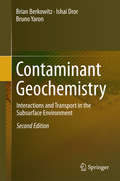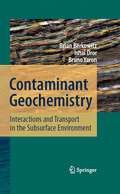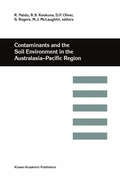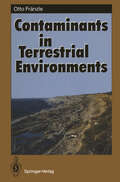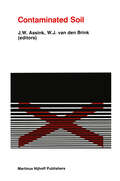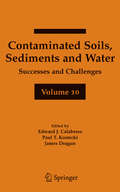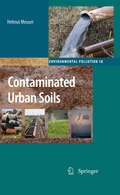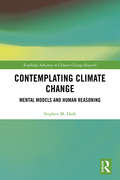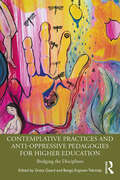- Table View
- List View
Consumerism in the Ancient World: Imports and Identity Construction (Routledge Monographs in Classical Studies)
by Justin St. P. WalshGreek pottery was exported around the ancient world in vast quantities over a period of several centuries. This book focuses on the Greek pottery consumed by people in the western Mediterranean and trans-Alpine Europe from 800-300 BCE, attempting to understand the distribution of vases, and particularly the reasons why people who were not Greek decided to acquire them. This new approach includes discussion of the ways in which objects take on different meanings in new contexts, the linkages between the consumption of goods and identity construction, and the utility of objects for signaling positive information about their owners to their community. The study includes a database of almost 24,000 artifacts from more than 230 sites in Portugal, Spain, France, Switzerland, and Germany. This data was mapped and analyzed using geostatistical techniques to reveal different patterns of consumption in different places and at different times. The development of the new approaches explored in this book has resulted in a shift away from reliance on the preserved fragments of ancient Greek authors’ descriptions of western Europe, remains of monumental buildings, and major artworks, and toward investigation of social life and more prosaic forms of material culture.
Consumers, Society and Marketing: A Sustainability Perspective (CSR, Sustainability, Ethics & Governance)
by Dilip S. Mutum Ezlika M. GhazaliEnvironment and social responsibility are paramount for any modern business strategy, and the field of marketing is adapting itself to the new focus on sustainability. The study of the interface between consumers, society, and marketing is crucial for understanding the complex interactions between individuals and the products and services they consume and the resulting implications. In this book, the authors delve into the latest research and theories on the subject, providing insight into the various factors that shape consumer behavior and the broader impacts of marketing on society. Whether you are a student, professional, or simply curious about the topic, this book will provide a valuable resource for your learning and exploration. Instead of treating ethical foundations and critical marketing perspectives separately, this book merges them and takes a broader sustainability perspective. It examines the various ways in which businesses are incorporating sustainability into their marketing strategies, and the impact these efforts are having on consumers, the economy, and the planet. Topics covered in this book include: Evolution of marketing thoughtCritique of marketingSustainable marketingSocial marketingEvolving consumer representations and roles, and many more
Consuming Geographies: We Are Where We Eat
by David Bell Gill ValentineFood occupies a seemingly mundane position in all our lives, yet the ways we think about shopping, cooking and eating are actually intensely reflexive. The daily pick and mix of our eating habits is one way we experience spatial scale. From the relationship of our food intake to our body-shape, to the impact of our tastes upon global food-production regimes, we all read food consumption as a practice which impacts on our sense of place.Drawing on anthropological, sociological and cultural readings of food consumption, as well as empirical material on shopping, cooking, food technology and the food media, this book demonstrates the importance of space and place in identity formation. We all think place (and) identity through food - we are where we eat!
Consuming Geographies: We Are Where We Eat
by David Bell Gill ValentineFood occupies a seemingly mundane position in all our lives, yet the ways we think about shopping, cooking and eating are actually intensely reflexive. The daily pick and mix of our eating habits is one way we experience spatial scale. From the relationship of our food intake to our body-shape, to the impact of our tastes upon global food-production regimes, we all read food consumption as a practice which impacts on our sense of place.Drawing on anthropological, sociological and cultural readings of food consumption, as well as empirical material on shopping, cooking, food technology and the food media, this book demonstrates the importance of space and place in identity formation. We all think place (and) identity through food - we are where we eat!
Consuming Interests: The Social Provision of Foods (Consumption And Space Ser.)
by Andrew Flynn Michelle Harrison Terry MarsdenCombining theory, research and policy Consuming Interests provides a topical interdisciplinary exploration into the nature of food provision, policy and regulation. The book provides a detailed examination of corporate retailers, state agencies and consumer organisations involved in the food sector. The analysis explores questions including: * what can the public expect from the state* what limits are there on state action* what are the most appropriate balancesbetween public and private interests in the provision of 'quality' foods.
Consuming Interests: The Social Provision of Foods
by Andrew Flynn Michelle Harrison Terry MarsdenCombining theory, research and policy Consuming Interests provides a topical interdisciplinary exploration into the nature of food provision, policy and regulation. The book provides a detailed examination of corporate retailers, state agencies and consumer organisations involved in the food sector. The analysis explores questions including: * what can the public expect from the state* what limits are there on state action* what are the most appropriate balancesbetween public and private interests in the provision of 'quality' foods.
Consuming Space: Placing Consumption in Perspective
by Michael K. Goodman David GoodmanAn examination of the relationship between space, place and consumption offers important insights into some of the most powerful forces constructing contemporary societies. Space and place are made and remade through consumption. Yet how do cultures of consumption discover space, and how do they construct place? This book addresses these questions by exploring the implications of conceptualizing consumption as a spatial, increasingly global, yet intensely localized activity. The work develops integrative approaches that articulate the processes involved in the production and consumption of space and place. The result is a varied, engaging, and innovative study of consumption and its role in structuring contemporary capitalist political economies.
Consuming Space: Placing Consumption in Perspective
by Michael K. Goodman David Goodman Michael RedcliftAn examination of the relationship between space, place and consumption offers important insights into some of the most powerful forces constructing contemporary societies. Space and place are made and remade through consumption. Yet how do cultures of consumption discover space, and how do they construct place? This book addresses these questions by exploring the implications of conceptualizing consumption as a spatial, increasingly global, yet intensely localized activity. The work develops integrative approaches that articulate the processes involved in the production and consumption of space and place. The result is a varied, engaging, and innovative study of consumption and its role in structuring contemporary capitalist political economies.
Consuming Tradition, Manufacturing Heritage: Global Norms and Urban Forms in the Age of Tourism
by Nezar AlsayyadFrom the Grand Tour to today's packages holidays, the last two centuries have witnessed an exponential growth in travel and tourism and, as the twenty-first century unfolds, people of every class and from every country will be wandering to every part of the planet.Meanwhile tourist destinations throughout the world find themselves in ever more fierce competition - those places marginalized in today's global industrial and information economy perceiving tourism as perhaps the only means of surviving. But mass tourism has raised the local and international passions as people decry the irreversible destruction of traditional places and historic sites.Against these trends and at a time when standardized products and services are marketed worldwide, there is an increasing demand for built environments that promise unique cultural experiences. This has led many nations and groups to engage in the parallel processes of facilitating the consumption of tradition and of manufacturing tradition.The contributors to this volume - drawn from a wide range of disciplines - address these themes within the following sections: Traditions and Tourism: Rethinking the "Other"; Imaging and Manufacturing Heritage; Manufacturing and Consuming: Global and Local. Their studies, dealing with very different times, environments and geographic locales, will shed new light on how tourist 'gaze' transforms the reality of built spaces into cultural imagery.
Consuming Tradition, Manufacturing Heritage: Global Norms and Urban Forms in the Age of Tourism
by Nezar AlSayyadFrom the Grand Tour to today's packages holidays, the last two centuries have witnessed an exponential growth in travel and tourism and, as the twenty-first century unfolds, people of every class and from every country will be wandering to every part of the planet.Meanwhile tourist destinations throughout the world find themselves in ever more fierce competition - those places marginalized in today's global industrial and information economy perceiving tourism as perhaps the only means of surviving. But mass tourism has raised the local and international passions as people decry the irreversible destruction of traditional places and historic sites.Against these trends and at a time when standardized products and services are marketed worldwide, there is an increasing demand for built environments that promise unique cultural experiences. This has led many nations and groups to engage in the parallel processes of facilitating the consumption of tradition and of manufacturing tradition.The contributors to this volume - drawn from a wide range of disciplines - address these themes within the following sections: Traditions and Tourism: Rethinking the "Other"; Imaging and Manufacturing Heritage; Manufacturing and Consuming: Global and Local. Their studies, dealing with very different times, environments and geographic locales, will shed new light on how tourist 'gaze' transforms the reality of built spaces into cultural imagery.
Consumption Corridors: Living a Good Life within Sustainable Limits (Routledge Focus on Environment and Sustainability)
by Doris Fuchs Marlyne Sahakian Tobias Gumbert Antonietta Di Giulio Michael Maniates Sylvia Lorek Antonia GrafConsumption Corridors: Living a Good Life within Sustainable Limits explores how to enhance peoples’ chances to live a good life in a world of ecological and social limits. Rejecting familiar recitations of problems of ecological decline and planetary boundaries, this compact book instead offers a spirited explication of what everyone desires: a good life. Fundamental concepts of the good life are explained and explored, as are forces that threaten the good life for all. The remedy, says the book’s seven international authors, lies with the concept of consumption corridors, enabled by mechanisms of citizen engagement and deliberative democracy. Across five concise chapters, readers are invited into conversation about how wellbeing can be enriched by social change that joins "needs satisfaction" with consumerist restraint, social justice, and environmental sustainability. In this endeavour, lower limits of consumption that ensure minimal needs satisfaction for all are important, and enjoy ample precedent. But upper limits to consumption, argue the authors, are equally essential, and attainable, especially in those domains where limits enhance rather than undermine essential freedoms. This book will be of great interest to students and scholars in the social sciences and humanities, and environmental and sustainability studies, as well as to community activists and the general public.
Consumption Corridors: Living a Good Life within Sustainable Limits (Routledge Focus on Environment and Sustainability)
by Doris Fuchs Marlyne Sahakian Tobias Gumbert Antonietta Di Giulio Michael Maniates Sylvia Lorek Antonia GrafConsumption Corridors: Living a Good Life within Sustainable Limits explores how to enhance peoples’ chances to live a good life in a world of ecological and social limits. Rejecting familiar recitations of problems of ecological decline and planetary boundaries, this compact book instead offers a spirited explication of what everyone desires: a good life. Fundamental concepts of the good life are explained and explored, as are forces that threaten the good life for all. The remedy, says the book’s seven international authors, lies with the concept of consumption corridors, enabled by mechanisms of citizen engagement and deliberative democracy. Across five concise chapters, readers are invited into conversation about how wellbeing can be enriched by social change that joins "needs satisfaction" with consumerist restraint, social justice, and environmental sustainability. In this endeavour, lower limits of consumption that ensure minimal needs satisfaction for all are important, and enjoy ample precedent. But upper limits to consumption, argue the authors, are equally essential, and attainable, especially in those domains where limits enhance rather than undermine essential freedoms. This book will be of great interest to students and scholars in the social sciences and humanities, and environmental and sustainability studies, as well as to community activists and the general public.
Contact and Symplectic Topology: Lectures From The Nantes Trimester 2011 And The Budapest Summer School 2012 (Bolyai Society Mathematical Studies #26)
by Frédéric Bourgeois Vincent Colin András StipsiczSymplectic and contact geometry naturally emerged from themathematical description of classical physics. The discovery of newrigidity phenomena and properties satisfied by these geometricstructures launched a new research field worldwide. The intenseactivity of many European research groups in this field is reflectedby the ESF Research Networking Programme "Contact And Symplectic Topology" (CAST). The lectures of the Summer School in Nantes (June 2011) and of the CAST Summer School in Budapest (July 2012) provide a nice panorama of many aspects of the present status of contact and symplectic topology. The notes of the minicourses offer a gentle introduction to topics which have developed in an amazing speed in the recent past. These topics include 3-dimensional and higher dimensional contact topology, Fukaya categories, asymptotically holomorphic methods in contact topology, bordered Floer homology, embedded contact homology, and flexibility results for Stein manifolds.
Contaminant Geochemistry: Interactions and Transport in the Subsurface Environment
by Brian Berkowitz Ishai Dror Bruno YaronIn this updated and expanded second edition, new literature has been added on contaminant fate in the soil-subsurface environment. In particular, more data on the behavior of inorganic contaminants and on engineered nanomaterials were included, the latter comprising a group of “emerging contaminants” that may reach the soil and subsurface zones.New chapters are devoted to a new perspective of contaminant geochemistry, namely irreversible changes in pristine land and subsurface systems following chemical contamination. Two chapters were added on this topic, focusing attention on the impact of chemical contaminants on the matrix and properties of both liquid and solid phases of soil and subsurface domains. Contaminant impacts on irreversible changes occurring in groundwater are discussed and their irreversible changes on the porous medium solid phase are surveyed. In contrast to the geological time scale controlling natural changes of porous media liquid and solid phases, the time scale associated with chemical pollutant induced changes is far shorter and extends over a “human lifetime scale”.
Contaminant Geochemistry: Interactions and Transport in the Subsurface Environment
by Brian Berkowitz Ishai Dror Bruno YaronCombining earth science, subsurface hydrology and environmental geochemistry, this book provides a comprehensive background for those interested in the protection and sustainable management of the subsurface environment. The reader is introduced to the chemistry of contaminants, which usually disturb the natural equilibrium in the subsurface as a result of human activity. One focus of the book is on contaminant reactions in soil solutions. Discussions on case studies are provided.
Contaminants and the Soil Environment in the Australasia-Pacific Region: Proceedings of the First Australasia-Pacific Conference on Contaminants and Soil Environment in the Australasia-Pacific Region, held in Adelaide, Australia, 18–23 February 1996
by R. Naidu R. S. Kookana D. P. Oliver S. Rogers M. J. McLaughlinThe Australasia-Pacific Region supports approximately 50% of the world's population. The last half-century has witnessed a rapid increase in the regional population, agricultural productivity, industrial activities and trade within the region. Both the demand for increased food production and the desire to improve the economic conditions have affected regional environmental quality. This volume presents an overview of the fate of contaminants in the soil environment; current soil management factors used to control contaminant impacts, issues related to sludge and effluent disposals in the soil environment; legal, health and social impacts of contaminated land, remediation approaches and strategies to manage contaminated land, some of the problems associated with environmental degradation in the Australasia-Pacific Region and steps that we need to take to safeguard our environment.
Contaminants in Terrestrial Environments (Springer Series in Physical Environment #13)
by Otto FränzleDefining ecology as a system-theory oriented synthesis of both earth and life sciences, the book aims at a novel co- herent understanding of chemicalimpact on the lower at- mosphere and characteristic types of terrestrial ecosystems. To this end comprehensive flux-analytical and hierarchical modelling approaches were developed and consulted, which in- clude a thorough consideration of the specific physical and geographic boundary conditions of the processes involved. The first part is devoted to fundamentals of environmental chemistry and ecology, while the second deals with the com- plex atmospheric pathways of anthropogenic chemicals. In the last part, the manifold interactions of these compounds or their metabolites with the soil-vegetation complex of eco- systems are described. Chapters on pollutant impact on mate- rials and a review of chemical fate modelling are included. Thus scientists and practitioners facing ecological projects may expect to obtain a deeper insight into landscape ecology from the impact point of view owing to the concise presenta- tion of complex mechanisms and the generalized modelling ap- proach.
Contaminated Rivers: A Geomorphological-Geochemical Approach to Site Assessment and Remediation
by Jerry R. Miller Suzanne M. Orbock MillerThis book provides an introductory understanding of fluvial geomorphic principles and how these principles can be integrated with geochemical data to cost-effectively characterize, assess and remediate contaminated rivers. The book stresses the importance of needing to understand both geomorphic and geochemical processes. Thus, the overall presentation is first an analysis of physical and chemical processes and, second, a discussion of how an understanding of these processes can be applied to specific aspects of site assessment and remediation. Such analyses provide the basis for a realistic prediction of the kinds of environmental responses that might be expected, for example, during future changes in climate or land-use.
Contaminated Soil: First International TNO Conference on Contaminated Soil 11–15 November, 1985, Utrecht, The Netherlands
by J. W. Assink W. J. Van Den BrinkF. J. COLON Chairman of the Scientific Committee TNO Division of Technology for Society, APELDOORN, The NETHERLANDS Only these past few years have we gained an insight into the full extent of the problems associated with contaminated soils. The first efforts to take effective remedial action at contaminated sites were seriously hampered by the lack of experience, knowledge and technology. Fortunately, this handicap has been partly alleviated by the experience we have gained in the numerous cases we have had, and -unfortunately still have to deal with. This meeting on contaminated soil is the first international conference to cover such a wide variety of subjects related to the problems that confront us in practice: behaviour of contaminants in soil - impacts on public health and the enviornment - role of governments and other authorities - site investigation and analysis - techniques for remedial action - management of remedial action and risk assessment - safety - case studies This Conference has been organized by the Netherlands Organization for Applied Scientific Research (TNO) in co-operation with the Netherlands Ministry of Housing, Physical Planning and the Environment (VROM). It goes without saying that the preparation would not have been possible without the assistance of many people throughout the world and the co-operation between government, industry and research organizations.
Contaminated Soils, Sediments and Water: Science in the Real World
by Edward J. Calabrese Paul T. Kostecki James DragunVolume 9 of the series presents 38 technical papers covering a wide range of environmental issues, including Bioremediation, Chemical Oxidation, Heavy Metals, MTBE, Phytoremediation, Radiation, Regulatory and Legal issues, Remediation, Risk Based Cleanup and Site Assessment. Contributing authors are drawn from across the spectrum of interest: government agencies, academic institutions, the consulting community and industrial companies.
Contaminated Soils, Sediments and Water Volume 10: Successes and Challenges
by Edward J. Calabrese Paul T. Kostecki James DragunEvery spring, the University of Massachusetts - Amherst welcomes all ''Soils Conference" Scientific Advisory Board members with open arms as we begin the planning process responsible for bringing you quality conferences year after year. With this "homecoming" of sorts comes the promise of reaching across the table and interacting with a wide spectrum of stakeholders, each of them bringing their unique perspective in support of a successful Conference in the fall. This year marks the 20^^ anniversary of what started as a couple of thoughtful scientists interested in developing partnerships that together could fuel the environmental cleanup dialogue. Since the passage of the Superfund Law, regulators, academia and industry have come to realize that models that depend exclusively on ''command and control" mandates as the operative underpinning limit our collective ability to bring hazardous waste sites to productive re-use. It is with this concern in mind that the Massachusetts Department of Environmental Protection privatized its cleanup program in 1993, spurring the close-out of over 20,000 sites and spills across the Commonwealth to date, in a manner that is both protective of human health and the environment while also flexible and responsive to varied site uses and redevelopment goals. So we gather together again, this year, to hear our collective stories and share success and challenges just as we share stories at a family gathering. Take a read through the stories contained in these proceedings.
Contaminated Urban Soils (Environmental Pollution #18)
by Helmut MeuserWith more than 50% of the world’s population already living in towns and cities, migration from rural areas continuing at an alarming rate in developing countries and suburbanisation using more and more land in developed countries, the urban environment has become supremely important with regard to human health and wellbeing. For centuries, urbanisation has caused relatively low level soil conta- nation mainly by various wastes. However, from the time of the Industrial Revolution onwards, both the scale of urban development and the degree of soil contamination rapidly increased and involved an ever widening spectrum of c- taminants. With constraints on the supply of land for new urban development in many countries, it is becoming increasingly necessary to re-use previously dev- oped (brownfield) sites and to deal with their accompanying suites of contaminants. It is therefore essential to fully understand the diversity and properties of urban soils, to assess the possible risks from the contaminants they contain and devise ways of cleaning up sites and/or minimizing hazards. The author, Helmut Meuser, is Professor of Soil Protection and Soil Clean-up at the University of Applied Sciences, Osnabrück and is one of Europe’s foremost experts on contamination from technogenic materials in urban soils. He has many years’ experience of research in Berlin, Essen, Osnabrück, other regions of Germany, and several other countries.
Contemplating Climate Change: Mental Models and Human Reasoning (Routledge Advances in Climate Change Research)
by Stephen M. DarkGlobal climate change policy has failed us all, but what is the reasoning that underlies this failure? Why are some people more disposed to reflect on confounding issues like climate change, recognise the danger, seek a solution, and act accordingly, more than others? This book is concerned with how we think and act in response to climate change. In particular, faced with deep uncertainty and the multifaceted complexities that characterise the climate change conundrum, how the various actors and institutions involved in the policymaking process make decisions that both aid and impede in the design and implementation of climate change policy. This book focuses on how these actors and institutions frame and use the knowledge available – under conditions of competing ideologies and interests – and synthesise it to form often-disparate mental models, or worldviews, that inspire them to become firm advocates of meaningful climate change action or indeed, sceptics that continue to downplay the threat, and hence the need for urgency. By exploring how we think about climate change and the disparate mental models we hold as a result, this book explores why humankind has thus far failed in its endeavours to solve the climate change problem. This book will be of great interest to students and scholars of climate change, environmental policy and environmental psychology.
Contemplating Climate Change: Mental Models and Human Reasoning (Routledge Advances in Climate Change Research)
by Stephen M. DarkGlobal climate change policy has failed us all, but what is the reasoning that underlies this failure? Why are some people more disposed to reflect on confounding issues like climate change, recognise the danger, seek a solution, and act accordingly, more than others? This book is concerned with how we think and act in response to climate change. In particular, faced with deep uncertainty and the multifaceted complexities that characterise the climate change conundrum, how the various actors and institutions involved in the policymaking process make decisions that both aid and impede in the design and implementation of climate change policy. This book focuses on how these actors and institutions frame and use the knowledge available – under conditions of competing ideologies and interests – and synthesise it to form often-disparate mental models, or worldviews, that inspire them to become firm advocates of meaningful climate change action or indeed, sceptics that continue to downplay the threat, and hence the need for urgency. By exploring how we think about climate change and the disparate mental models we hold as a result, this book explores why humankind has thus far failed in its endeavours to solve the climate change problem. This book will be of great interest to students and scholars of climate change, environmental policy and environmental psychology.
Contemplative Practices and Anti-Oppressive Pedagogies for Higher Education: Bridging the Disciplines
by Greta Gaard Bengü Ergüner-TekinalpThis volume explores mindfulness and other contemplative approaches as strategic tools for cultivating anti-oppressive pedagogies in higher education. Research confirms that simply providing students with evidence and narratives of economic, social, and environmental injustices proves insufficient in developing awareness and eliciting responses of empathy, solidarity, and a desire to act for change. From the environmental humanities to the environmental sciences, legal studies, psychology, and counseling, educators from a range of geographical and disciplinary standpoints describe their research-based mindfulness pedagogies. Chapters explore how to interrupt and interrogate oppression through contemplative teaching tools, assignments, and strategies that create greater awareness and facilitate deeper engagement with learning contents, contexts, and communities. Providing a framework that facilitates awareness of the links between historic and current oppression, self-identity, and trauma, and creating a transformative learning experience through mindfulness, this book is a must-read for faculty and educators interested in intersections of mindfulness, contemplative pedagogies, and anti-oppression.








